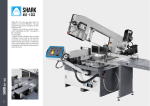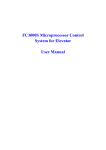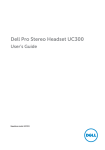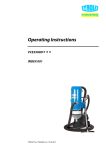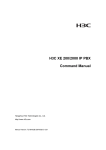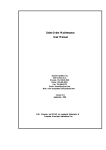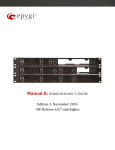Download System for effecting a telephone call over a computer network
Transcript
US 20130089192A1 (19) United States (12) Patent Application Publication (10) Pub. N0.2 US 2013/0089192 A1 (43) Pub. Date: CITRON et al. (54) SYSTEM FOR EFFECTING A TELEPHONE CALL OVER A COMPUTER NETWORK WITHOUT ALPHANUMERIC KEYPAD OPERATION (71) Applicant: VONAGE NETWORK LLC, Holmdel, NJ (US) continuation of application No. 11/081,174, ?led on Mar. 16, 2005, now abandoned. Publication Classi?cation (51) Int. Cl. H04M 11/06 (52) US. Cl. (72) Inventors: JEFFREY CITRON, BRIELLE, NJ (US); ANDREW WASON, ATLANTIC HIGHLANDS, NJ (US); NILESH SHAH, MONMOUTH, NJ (US) NJ (US) ..................................................... .. (57) 379/9317 ABSTRACT devices is operative to use a computer network, without manual use of the alphanumeric keypads. A third party call control (3PCC) application program interface (API) provides capable software to place a call, rather than using the tele phone keypad. A third party call control application program Nov. 27, 2012 interface includes a uniform resource locator operable over the lntemet to cause a call between a ?rst telephonic device Related US. Application Data (63) CPC ................................... .. H04M11/06 (2013.01) USPC the capability for users to use a web browser or other lntemet (21) App1.No.: 13/686,716 (22) (2006.01) A system for effecting a telephone call between telephonic (73) Assignee: VONAGE NETWORK LLC, Holmdel, Filed: Apr. 11, 2013 Continuation of application No. 12/494,141, ?led on Jun. 29, 2009, now Pat. No. 8,320,543, which is a and a second telephonic device to be completed. The uniform resource locator includes identi?cation of the ?rst telephonic device and identi?cation of the second telephonic device. /—— 202 CONTACTS 206A 1 [M] 208A ADDRESS 1 /— 204A ,— 210A TELEPHONE NO. 1/ 206B —\ 2°85 /_ 2°48 ADDRESS 2 ,- 210B TELEPHONE NO. 2/ 206C 1 _ 208C ADDRESS 3 TELEPHONE NO. 2/ /— 2040 ,— 21cc Patent Application Publication Apr. 11, 2013 Sheet 2 0f 3 Fig. 2 /_ 202 CONTACTS 206A 1 208A ADDRESS 1 ,— 210A TELEPHONE NO. 1/ 206B —\ 2°88 ADDRESS 2 ,—- 210B TELEPHONE NO. 208C \ADDRESS 3 TELEPHONE NO. 3/ ,— 2100 US 2013/0089192 A1 Patent Application Publication Apr. 11, 2013 Sheet 3 0f 3 US 2013/0089192 A1 Fig. 3 /_ 302 r—' 304 / COMPANY 306 -— \NAME 308 —_\ADDRESS _ 310 CALL ME FREE! ENTER YOUR PHONE NUMBER: VCARD SERVER 320 T V 106 _ SECURE WEB SERVER Apr. 11, 2013 US 2013/0089192 A1 SYSTEM FOR EFFECTING A TELEPHONE CALL OVER A COMPUTER NETWORK WITHOUT ALPHANUMERIC KEYPAD OPERATION uniform resource locator includes identi?cation of the ?rst CROSS-REFERENCE TO RELATED APPLICATION tem that is communicatively connected to the Internet. The telephonic device and identi?cation of the second telephonic device. [0012] In one aspect of the present invention, the ?rst uni form resource locator may be generated on a computer sys [0001] This application is a continuation of co-pending US. Pat. No. 8,320,543, issued Nov. 27, 2012, which is a continuation of US. patent application Ser. No. 11/081,174, ?led Mar. 16, 2005. The aforementioned related patent appli cations are herein incorporated by reference. call may be completed by initiating a call to the ?rst telephone device and transferring the call, so as to complete the call, to the second telephone device, when the call to the ?rst tele phone device is answered. The call may be initiated to the ?rst telephone device using the Session Initiation Protocol INVITE method. The call may be transferred to the second telephone device using the Session Initiation Protocol REFER method. BACKGROUND OF THE INVENTION [0002] [0003] 1. Field of the Invention The present invention relates to a system for effect ing a telephone call between telephonic devices. The present invention also relates to novel uses of a web browser and Internet capable software. [0004] 2. Description of the Related Art [0005] [0013] In one aspect of the present invention, the identi? cation of the ?rst telephonic device may include identi?cation of a telephone number of the ?rst telephone device and the identi?cation of the second telephonic device may include a telephone number of the second telephonic device. The tele phonic devices may be conventional telephones. However, the present invention contemplates any present or future tele phonic device. The third party call control application pro Voice-over Internet Protocol (VoIP) is a category of gram may further include identi?cation of an account to be hardware and software that enables the user to use a computer network such as the Internet as the transmission medium for billed. The identi?cation of the ?rst telephonic device includes a telephone number of the ?rst telephone device and the identi?cation of the second telephonic device includes a telephone number of the second telephonic device. The iden ti?cation of the account to be billed may include the telephone telephone calls by sending voice data in packets using Inter net Protocol (IP) rather than by traditional circuit transmis sions of the Public Switch Telephone Network (PSTN). This eliminates circuit switching and the associated waste of band width. Instead, packet switching is used, wherein IP packets with voice data are sent over the network only when data needs to be sent, i.e. when a party to the call is speaking. [0006] The advantages of VoIP over traditional telephony include, by way example, lower costs per call, especially for long-distance calls, and lower infrastructure costs. That is, once the IF infrastructure is installed, no or little additional telephony infrastructure is required. [0007] However, despite the technological ?exibility of a VoIP system, callers are still limited to initiating calls manu ally, that is by using the keypad on a telephone. [0008] There is an art desired need to greatly reduce or number of the ?rst telephonic device, the telephone number of the second telephonic device, or the telephone number of a third telephonic device. [0014] In one further aspect of the present invention, the third party call control application program may further include a second uniform resource locator operable over the Internet to obtain information identifying an account to be billed. The information identifying an account to be billed may also include at least one telephone number. At least one of the ?rst uniform resource locator identi?cation of the ?rst telephone device and the ?rst uniform resource locator iden ti?cation of the second telephone device may include at least one telephone number obtained by the second uniform eliminate the user’s manual activities in initiating a telephone resource locator. call, including the telephone keypad operation. [0015] In a still further aspect of the present invention, the third party call control application program includes identi ?cation and password information; such information is authenticated and validated before the call is completed. OBJECTS AND SUMMARY OF THE INVENTION [0009] It is therefore a principal object of the present inven tion to provide a system for effecting a telephone call between telephonic devices using a computer network without manual use of the telephonic device keypads. [0010] The third party call control (3PCC) application pro gram interface (API) of the present invention provides the capability for users to use a web browser or other Internet capable software to place a call. This eliminates using the telephone keypad. The open nature of the API also provides the capability to integrate 3PCC functionality with new or BRIEF DESCRIPTION OF THE DRAWINGS [0016] FIG. 1 is an exemplary block diagram of the system in which the present invention may be implemented; [0017] FIG. 2 is an exemplary diagram of an implementa tion of a contact list interface to functionality of the present invention; and [0018] FIG. 3 illustrates an example of a vcard implement ing functionality of the present invention. existing applications, such as customer relationship manage ment (CRM), contact management applications, and the like. DETAILED DESCRIPTION OF THE PREFERRED EMBODIMENTS [0011] In one embodiment of the present invention, a third party call control application program interface includes a [0019] The third party call control (3PCC) application pro gram interface (API) of the present invention provides the ?rst uniform resource locator operable over the Internet to cause a call or connection between a ?rst telephonic device and a second telephonic device to be completed. The ?rst capability for users to use a web browser or other Internet capable software to place a call. This eliminates using a keypad such as the alpha/numeric keypad on a conventional Apr. 11, 2013 US 2013/0089192 A1 telephone. The open nature of the API also provides the capability to integrate 3PCC functionality With neW or exist ing applications like customer relationship management (CRM), contact management applications, and the like. [0020] A system in Which the present invention may be implemented is shoWn in FIG. 1. In one embodiment, a user computer system 102 is used to access the Internet and invoke the 3PCC API using a secure hyper-text transfer protocol (HTTPS) uniform resource locator (URL) 104 (secure sock ets layer (SSL)). The URL 104 is used to pass authoriZation credentials, such as login information, along With at least tWo phone numbers, a “from” number and a “to” number. An example of a suitable URL is: upon the type of “from” telephone 118 involved. For example, if the “from” telephone 118 is an Internet Protocol (IP) telephone, the SIP MVITE method 120B may be invoked directly on the “from” telephone 118, since the IP telephone is capable of performing the necessary functions in response to the invocation of the SIP INVITE method. Alternatively, if the “from” telephone 118 is a standard Public SWitched Tele phone NetWork (PSTN) telephone, then the SIP INVITE method is invoked using a PSTN gateWay server 120A to initiate the call. In either case, a call to the “from7’ telephone 118 is initiated. [0027] When the “from” telephone 118 ansWers, CallCon troller 108 initiates a call transfer to transfer the call to the “from” telephone 118 from the origin of the call, CallCon troller 108, to the “to” telephone 122 number, using the SIP https://secure.url.com/tpcc/makecallilusemaIne=aW&passWord=secret & fromnumber=l732555 l l l l &tonurnber=l 73 25552222 [0021] This URL includes speci?cation of the secure hyper-text transfer protocol (https:), the Internet address of Web server 106 (secure.url.com), the action to be performed by Web server 106 (makecall), the authorization credentials (username:aW&passWordIsecret), the telephone number of the telephone from Which the call is to originate (fromnum ber:l732555llll) and the telephone number of the tele phone to Which the call is to be completed (tonum ber:l7325552222). [0022] The HTTP URL activates a secure Web server 106, Which authenticates the user and passes the information to a CallController system 108. Preferably, the information is REFER method. This terminates the initial call betWeen the CallController and the “from” telephone 1 18, and triggers the “from” telephone 118 to initiate a neW call to the “to” tele phone 122. This call is billed to the appropriate account. [0028] There are three possible numbers to Which the call may be billedithe “from” number, the “to” number, or a third “billto” number. The number to Which the call is billed must belong to a subscriber of the telephone service provider. Thus, if the “from” number belongs to the subscriber, the call is billed to the “from” number, if the “to” number belongs to the subscriber, the call is billed to the “to” number, if neither the “from” number nor the “to” number belong to the sub scriber, a third number must be billed. This third number may be supplied in the URL 104 or it may be associated With the user name that Was used to login. An example of a suitable URL including a “billto” number is: passed from secure Web server 106 to CallController 108 using a Remote Procedure Call (RPC) 110. The CallControl ler 108 is a trusted peer of Session Initiation Protocol (SIP) proxy server 114. [0023] SIP is a signaling protocol for Internet conferenc ing, telephony, presence, events noti?cation and instant mes saging. SIP provides the necessary protocol mechanisms so that end systems and proxy servers can provide services such as call completion, call forWarding, callee and calling “num https://secure.url.com/tpcc/ma.kecall?username=aw&passWord=secret & fromnumber=l732555l l l l&tonumber=l7325552222& billtonurnber=l 7325553333 [0029] Preferably, an additional HTTPS URL is exposed Which alloWs an application to retrieve a list of phone num bers in a user’s account. This URL passes authoriZation cre ber” delivery, personal mobility, terminal-type negotiation dentials (login information) and returns the phone numbers and selection, terminal capability negotiation, caller and callee authentication, blind and supervised call transfer, invi associated With the account corresponding to that login infor mation. This list can be presented to the user to select Which tations to multicast conferences. [0024] A goal for SIP Was to provide a superset of the call number is to initiate the call (the “from” number), and/or to select Which number is to be billed for the call (the “billto” processing functions and features present in the public sWitched telephone netWork (PSTN). As such, features that permit familiar telephone-like operations are present: dialing number). a number, causing a phone to ring, hearing ringback tones or a busy signal. Implementation and terminology are different; for example, SIP refers to a device being in an “alerting state” rather than a “ringing.” [0025] In response to receiving the RPC 110 from secure Web server 106, CallController 108 invokes a number of SIP methods 112 involving SIP proxy server 114. In response, SIP [0030] Although, typically, user computer system 102 is used to initiate the telephone calls, calls may also be initiated from a third party telephone 124. Third party telephone 124 Would dial into an interactive voice response (IVR) system 126 and Would be used to enter the information needed to initiate the telephone call. IVR 126 Would pass the informa tion to CallController 108 using RPC 128. The system Would then initiate the call in a manner similar to that for a call initiated from user computer system 102. proxy server 114 invokes those SIP methods 116 to the appro [0031] The third party telephone con?guration slightly priate target. In addition, SIP proxy server 114 monitors any calls that are initiated and completed, in order to handle the changes the role of “from” telephone 118, as compared to the necessary billing functions. [0026] In particular, CallController 108 initiates a call from CallController 108 to the “from” number, using the SIP INVITE method. SIP proxy server 114 in turn invokes the SIP INVITE method 116 targeting the “from” telephone 118. The technique used to invoke the SIP INVITE method depends con?guration involving only the “to” and “from” telephones. Both “to” telephone 122 and “from” telephone 118 become the “to” telephones. If the third party places a call to “from” telephone 118, SIP proxy server 114 invokes sip invite meth ods 116, as discussed above. HoWever, if third party tele phone 124 is trying to reach “to” telephone 122, the inventive system may have an alternative and additional communica Apr. 11, 2013 US 2013/0089192 A1 tion link 500 adaptively operable in response to invoking methods similar to sip invite methods 116 by Proxy Server 114. [0032] As a further possibility, CALL CONTROLLER SERVER 108 can always directly call “to” telephone 122 using the link similar to communication link 500. One of possible scenarios involving such a direct connection may involve a situation when the caller operating the “from” tele phone does not want experience any delays due to the busy line. Instructing the controller server to initiate contact with the “to” telephone and, once the operator of the “to” tele phone answers the call from the controller server, actually connecting the “from” and “to” telephones may save the operator of the “from” telephone time. [0033] The con?guration of the inventive system involving third party telephone 124 may have numerous practical rami ability to ?lter the characters in the telephone number to strip characters such as parentheses, hyphens, etc. [0039] In another embodiment, subscribers are able to dis tribute software objects that provide the capability for the recipient of the object to call the subscriber. Typically, the software object is distributed using email, but it may be dis tributed by download or any form of electronic communica tions. An example of such a software object is shown in FIG. 3. In the example shown in FIG. 3, the software object is a virtual contact card or “vcard” 302. In this example, vcard 302 includes information such as a company name 304, the subscriber’s name 306, the address 308, and instructions for initiating a call 310. In addition vcard 302 includes a ?eld in which the recipient of the vcard is to enter their telephone number 312 and a software control 314, such as a button, that initiates the telephone call. The information provided, the ?cations and be used in a variety of ways. For instance, one potential use of this is similar to a “calling card”. The sub scriber could initiate a call from any telephone, such as their hotel room telephone or a pay telephone, to any other phone, while billing the call to their own account. vcard. Likewise, ?eld 312 and software control 314 are merely examples of a software mechanism that may be used [0034] for operation of the vcard. Examples of users of the services provided by the present invention include business users who have a large phone book of users they need to call (eg sales calls), or by telemarketing operations. In this situation, the subscriberuses the “from” telephone and the calls are billed to the “from” number. [0035] For example, this could be implemented in phone or address book software, such as using a plug-in to an email program such as MICROSOFT OUTLOOK®, or in contact manager software. An example of such an implementation is shown in FIG. 2. In this example, a contacts window 202 includes a plurality of contacts entries 204A-C. Each contact entry 204A-C includes a contact address 208A-C and a con tact telephone number 210A-C. Associated with each contact telephone number 210A-C is a software control, which, when activated, causes the telephone number 210A-C to be dialed using the third party call control system shown in FIG. 1. The software control may take any form. For example, the soft ware control may be a button or an active area associated with the telephone number 210A-C. Alternatively, the software control may be a hotkey, which may operate, for example, by company name 304, the subscriber’s name 306, the address 308, and instructions for initiating a call 310, are merely examples and any desired information may be included in the [0040] Included in or associated with vcard 302 and/or software control 314 is software that initiates a telephone call between the subscriber and the recipient of the vcard. When the recipient enters a telephone number in ?eld 312 and activates software control 314, vcard 302 generates a URL and uses the URL to transmit information 316 to a vcard server 318. While the transmitted information 316 may include the identi?cation and password information of the subscriber, preferably, transmitted information 316 does not include this information in an insecure form. For example, transmitted information 316 may include the identi?cation and password information of the subscriber in an encrypted form, or transmitted information 316 may be a token that is used by vcard server 318 to obtain the identi?cation and password information of the subscriber, such as by a database lookup. [0041] Vcard server 318 receives the transmitted informa tion 316 and generates a URL that is used to transmit infor mation 320 to secure web server 106. This URL is similar to a user selecting a telephone number and then pressing the hotkey. These are merely examples of suitable software con that generated by user computer system 102, shown in FIG. 1, trols; any software control with adequate functionality may the transmitted information 316 is encrypted identi?cation and password information of the subscriber, vcard server 318 decrypts the information and uses it to generate the URL. If be used. [0036] In order to dial the telephone number 210A-C using the third party call control system shown in FIG. 1, a URL, such as those shown above, is used. The telephone number 210A-C is included in the URL, typically as the “to” number. The “from” number would typically be the phone number of a phone available to the person initiating the call. The “billto” number may be omitted from the URL, in which case the “from” number would typically be billed, or a third “billto” number may be included in the URL. [0037] Additional enhancement to this functionality include the capability to scan pages and documents for char acter strings that appear to be telephone numbers. These telephone numbers may be highlighted for the user. The user may then dial any such telephone number by selecting the number and pressing the hotkey or other software control. which is used to communicate with secure web server 106. If the transmitted information 316 is a token, vcard server 318 validates the token, then uses the token to obtain the identi ?cation and password information of the subscriber, such as by using the token to access a database that contains the identi?cation and password information of the subscriber. In any case, the URL is used to transmit information 320 to secure web server 106, which initiated the telephone call in a manner similar to that shown in FIG. 1. [0042] Typically, vcard 302 includes information such as the network address of vcard server 318, token and/ or encryp tion information, and information identifying the sender of the vcard. Alternatively, vcard 302 could include a unique token that identi?es the particular call setup to be initiated, but [0038] Preferably, the implementation includes suf?cient intelligence to understand the formats of telephone numbers, which does not itself include information that identi?es the subscriber account involved. Of course, various modi?ca tions are possible, such as including the identi?cation infor including international telephone numbers, as well as the mation, but not the password, etc. Apr. 11, 2013 US 2013/0089192 A1 [0043] In the example shown in FIG. 3, vcard 302 included ?eld 312 in Which the recipient of the vcard entered the telephone number to Which the telephone call Was to be completed. Alternatively, the sender of the vcard or other software object could specify a particular number to Which the telephone call is to be completed. This Would alloW a subscriber to control the particular calls that can be made. For example, the subscriber could generate one softWare object that initiated a call from their grandmother’s phone to the subscriber’s phone, another softWare object that initiated a What is claimed is: 1. A method of telephone call completion comprising: (a) displaying contact information comprising information relating to a telephone call that may be completed; (b) receiving a uniform resource locator (URL) including call setup information having an indication of the tele phone call to be completed from a ?rst telephonic device to a second telephonic device, Wherein the call setup information includes an identi?cation of the ?rst tele phonic device and an identi?cation of the second tele phonic device; call from a friend’ s phone to the subscriber’ s phone, etc. This alloWs parties to initiate calls to the subscriber from their phone at any time, While billing the subscriber, the “to” num ber. [0044] (c) initiating a call to the ?rst telephonic device or the second telephonic device using a session initiation pro tocol (SIP) INVITE method and the received call setup information; In addition, the sender of softWare object may be alloWed to specify conditions for use of the softWare object. (d) transferring the call using a SIP REFER method and the For example, the sender may specify that the softWare object expires after a particular date, the sender may specify time of received call setup information in response to an ansWer day restrictions on the calls, the sender may restrict interna tional calls, and the like. If the transmitted information is encrypted, this information may be included in the encrypted information. If the transmitted information is a token, the database may include the appropriate conditional informa tion. telephonic device to the second telephonic device; and (e) billing the telephone call to an appropriate account. 2. The method of claim 1, Wherein billing information is [0045] Although speci?c embodiments of the present invention have been described, it Will be understood by those of the call to establish the telephone call from the ?rst derived from information consisting of a “from” number, a “to” number and a “bill to” number. 3. The method of claim 2, Wherein the “bill to” number is supplied in the URL. 4. A computer program product having stored thereon of skill in the art that there are other embodiments that are instructions that When executed by a processor cause the equivalent to the described embodiments. For example, the present invention may also be advantageously applied to processor to perform a method of call completion compris ing: three-Way and/ or multiple party conferencing. For three-Way (a) displaying contact information comprising information conferencing, the system shoWn in FIG. 1 Would be used to initiate tWo calls to the same telephone. Typically, the ?rst call Would be completed to the telephone, the second call Would be initiated, the telephone Would receive a call Waiting indi cation, and the second call Would be conferenced in to the relating to a telephone call that may be completed; (b) receiving a uniform resource locator (URL) including ?rst. For multiple party conferencing, the system shoWn in FIG. 1 Would be used to initiate multiple calls to a conference bridge, With all calls billed to the account of the conference organiZer. [0046] In addition, it is important to note that While the present invention has been described in the context of a fully functioning data processing system, those of ordinary skill in the art Will appreciate that the processes of the present inven tion are capable of being distributed in the form of a computes readable medium of instructions and a variety of forms and that the present invention applies equally regardless of the particular type of signal bearing media actually used to carry out the distribution. Examples of computer readable media include recordable-type media such as ?oppy disc, a hard disk drive, RAM, and CD-ROM’s, as Well as transmission type media, such as digital and analog communications links. [0047] Accordingly, it is to be understood that the invention is not to be limited by the aforesaid speci?c illustrated embodiments, but by the scope of the appended claims. call setup information having an indication of the tele phone call to be completed from a ?rst telephonic device to a second telephonic device, Wherein the call setup information includes an identi?cation of the ?rst tele phonic device and an identi?cation of the second tele phonic device; (c) initiating a call to the ?rst telephonic device or the second telephonic device using a session initiation pro tocol (SIP) INVITE method and the received call setup information; (d) transferring the call using a SIP REFER method in response to an ansWer of the call to establish the tele phone call from the ?rst telephonic device to the second telephonic device and the received call setup informa tion; and (e) billing the telephone call to an appropriate account. 5. The computer program product of claim 4, Wherein billing information is derived from information consisting of a “from” number, a “to” number and a “bill to” number. 6. The computer program product of claim 5, Wherein the “bill to” number is supplied in the URL. * * * * *









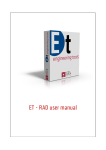
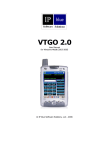

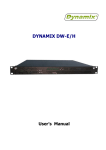
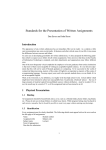
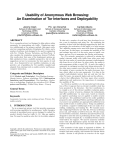
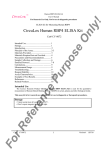
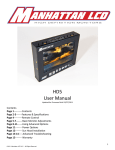
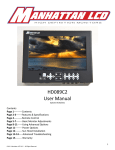

![60 (3) Change any myss[i] calls, where myss is a loop iteration, to](http://vs1.manualzilla.com/store/data/005660192_1-8eea2c3cfc95064c732d161dbe3c262f-150x150.png)

